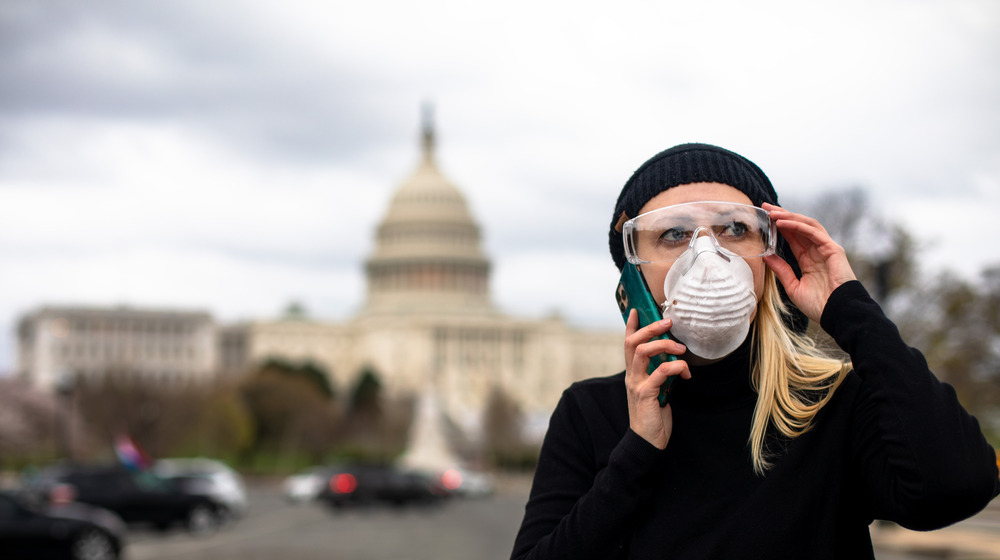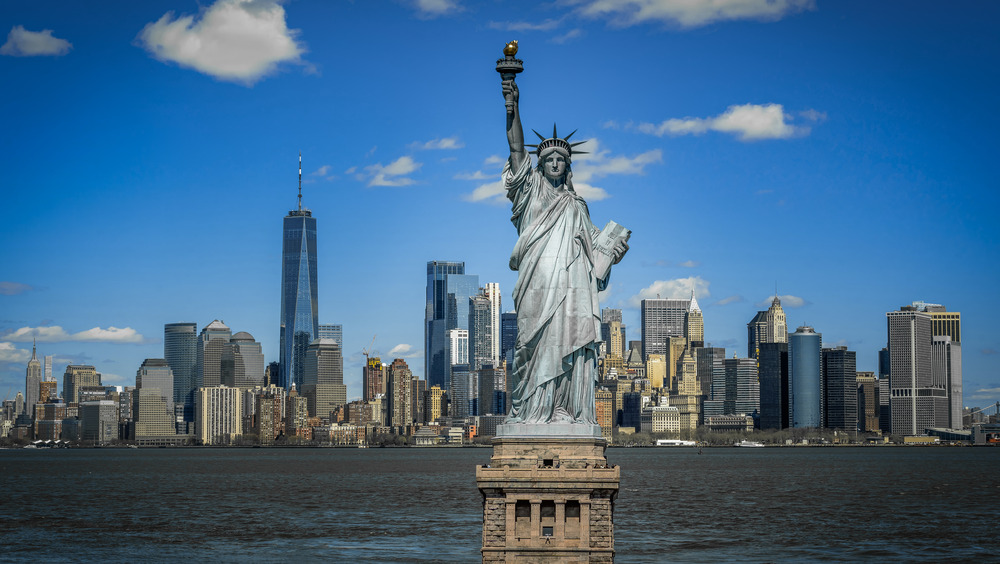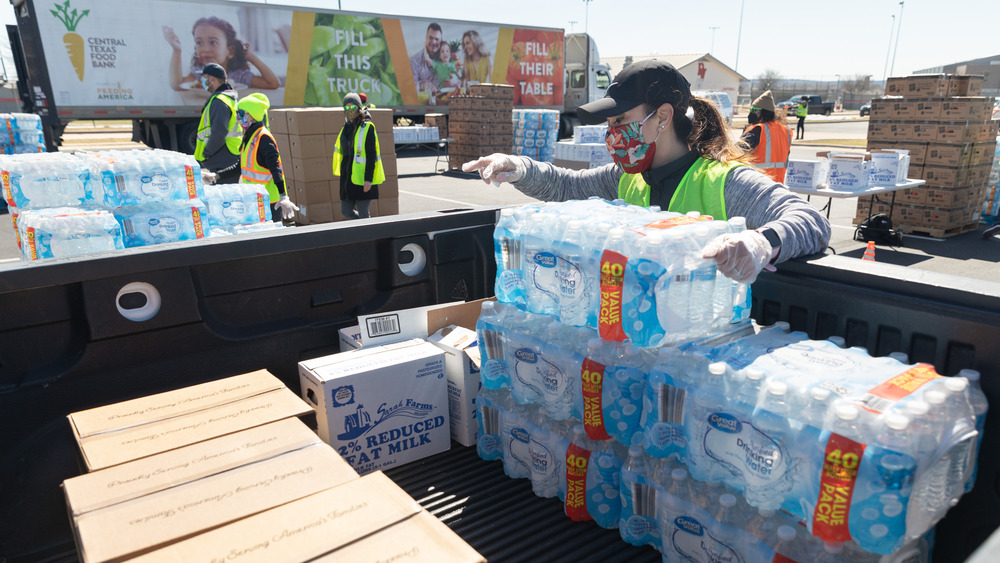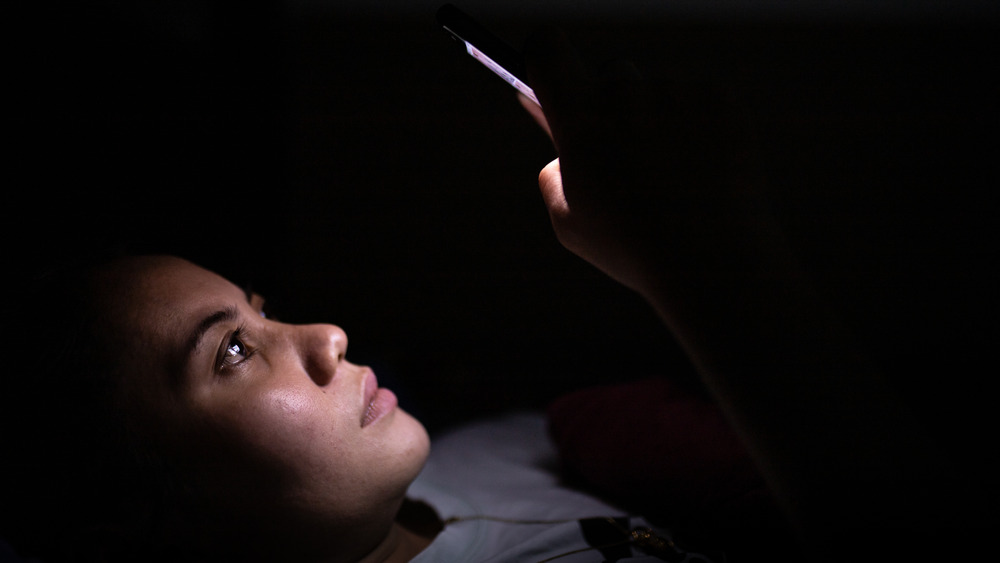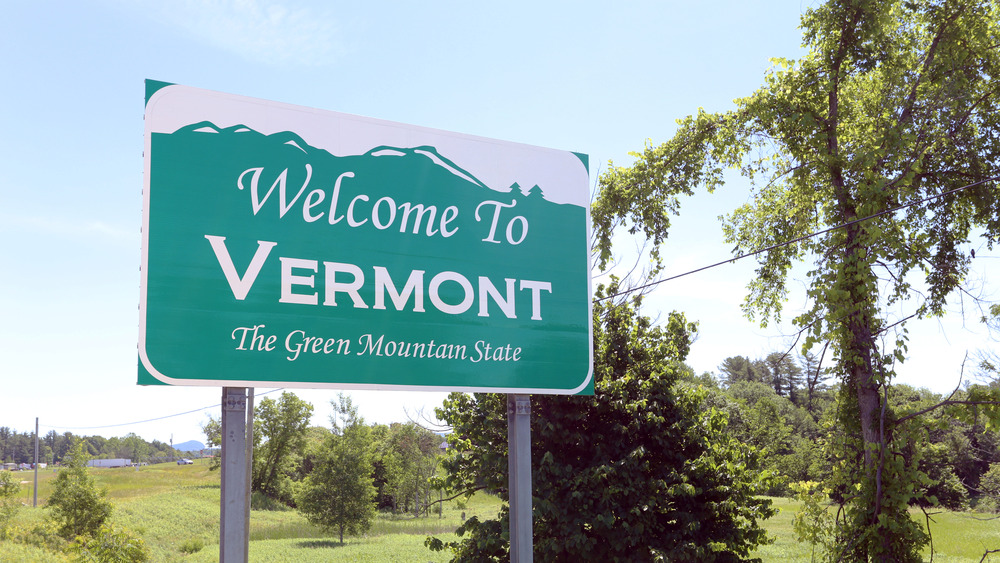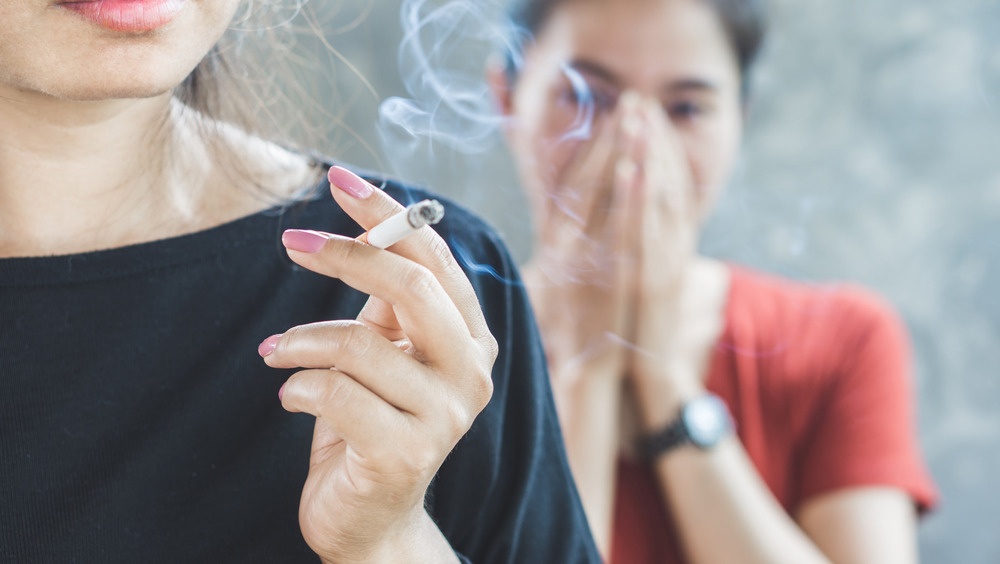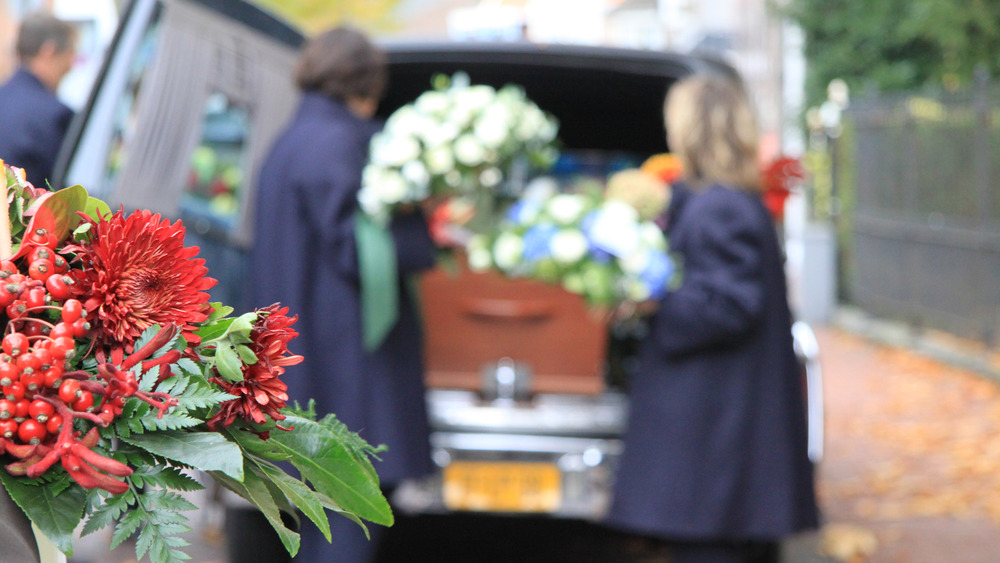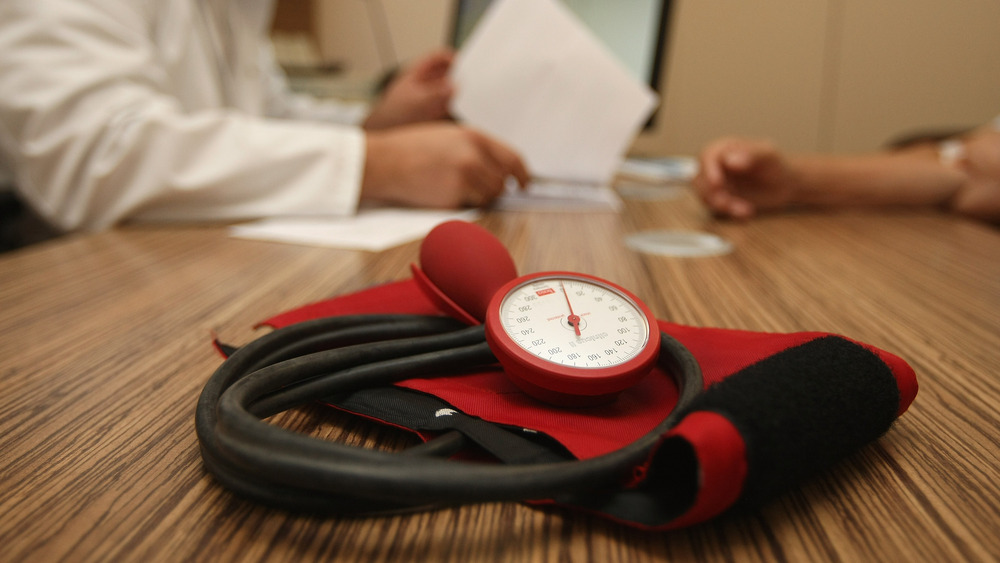The Healthiest And Unhealthiest States In America
The World Health Organization defines health as "a state of complete physical, mental, and social well-being and not merely the absence of disease or infirmity." Many factors contribute to our overall health: education, social support, access to quality food and healthcare — to name just a few. But it may surprise Americans to know that the biggest predictor of your health is not your income, your genetics, or even your lifestyle habits: it's your zip code (via Time).
The United States may be the wealthiest nation on the planet, but it's got a long way to go in terms of reducing inequality and inequity, which has a direct impact on the health (or lack thereof) of its citizens. For the last 30 years, the United Health Foundation has released an annual report called America's Health Rankings, detailing the healthiest and unhealthiest states in our union. The report for 2020 did not offer overall rankings, in light of the ongoing unprecedented public health crisis that is COVID-19. But it still ranked states on over 70 different individual metrics, across four categories: social and economic factors, physical environment, clinical care and behaviors. Read on to find out more.
New York is the worst state for income inequality
The United Health Foundation (UHF) ranks states' income inequality by using a ratio of the median 80th percentile household income to the median 20th percentile. Utah ranks as the "healthiest" in this category, with the lowest ratio of income inequality. According to the United States Census Bureau's 2019 American Community Survey, only 6% of Utahns make less than $15,000 per year, while 15% make over $150,000.
The Empire State of New York has the worst rate of income inequality in the country: About 11% make less than $15,000 per year, while around 21% make over $150,000.
The top 20% of households in the United States made about half of all income in 2019, according to the UHF — an unsurprising figure since income inequality has been on the rise for the last 50 years. The report points out that income inequality creates chronic stress, which can lead to a host of poor health outcomes: shorter life expectancy, fewer high school and college graduates, and more "mental illness, obesity, infant mortality, teenage births, homicides and imprisonment." People of color and women are more affected by income inequality than white men.
Maine is the safest state when it comes to violent crime
Violent crime, which includes aggravated assault, robberies, sexual assault, and murder, has been on the decline in the United States for almost 30 years, according to 2019 data from the Department of Justice and the FBI analyzed by the United Health Foundation (UHF). Maine scores the healthiest in this category, with only 115 violent crimes reported per year per 100,000 residents. Alaska fares the worst, with 867 violent crimes reported per 100,000 residents — that's 14% higher than the national average in 1992, the last most violent year in the U.S.
Violent crime has many negative trickle-down consequences for individuals, families, and communities, according to UHF. These crimes don't just cause physical harm; they can lead to profound social and emotional distress that contributes to depression, anxiety, and post-traumatic stress disorder. It can also cause declines in physical fitness: A 2016 study in the Journal of Health Economics found that higher rates of local violent crime were associated with lower rates of walking — and for many adults, walking is their only source of physical activity.
In 2018, homicide was the third leading cause of death for people aged 15-34, behind only suicide and accidents, according to the Centers for Disease Control and Prevention.
California has the unhealthiest air
Whether you can see it or not (looking at you, L.A.), air pollution is seriously bad for your health. California had the unhealthiest air in the country in 2019, according to data from the U.S. Environmental Protection Agency that was analyzed by the United Health Foundation (UHF). A sharp decrease in car use during the COVID-19 pandemic showed that commuting was not the biggest air offender. Instead, wildfires and ozone-generating heat waves contribute significantly to air pollution in the Golden State (via the Los Angeles Times).
New Hampshire had the best air quality in 2019, with only a quarter of the level of pollution observed in California — perhaps not surprising, as New Hampshire is the second most forested state in America, with 81% of its land covered by wilderness.
Exposure to air pollution can lead to alarming health consequences, including heart and lung diseases "and even premature death," according to data compiled by the UHF. A 2019 research study from the Proceedings of the National Academy of Sciences estimated that man-made fine particulate matter (microscopic pollution we inhale that's dozens of times smaller than the thickness of a single human hair) contributed to over 100,000 deaths in the United States in 2011.
Iowa has the 'healthiest' high school graduation rates
Iowa has the "healthiest" high school graduation rate, with 91.4% of students graduating within four years of starting ninth grade, according to data from the U.S. Department of Education analyzed by the United Health Foundation (UHF). At least 90% of students also graduate high school in four years in New Jersey, Kentucky, West Virginia, Alabama, Tennessee, and Texas. New Mexico is the unhealthiest state for high school graduation, with only 73.9% of students graduating in four years. That means that 1 out of 4 high school freshmen will not graduate on time.
Success in school is a huge predictor of good future health, with more completed education being associated with not only better jobs and higher pay, but also specifically better health literacy, better self-reported health, and fewer chronic ailments like obesity and heart disease, according to the UHF.
Those health benefits do not flow equally to all. The United States has a poor track record when it comes to racial, ethnic, and economic equity in education, and disturbingly, segregation in public schools is getting worse, according to the U.S. Government Accountability Office, which perpetuates health disparities for minority and low-income Americans.
West Virginia has the least safe drinking water for its residents
Nearly 20% of West Virginians — that's 1 in 5 residents — got their water from a municipal system with at least one serious drinking water violation during 2020, according to data from the EPA that was analyzed by the United Health Foundation (UHF). Eleven states — California, Delaware, Hawaii, Iowa, Maryland, Massachusetts, Nebraska, North Carolina, Rhode Island, South Carolina, and Virginia — had zero violations for 2020.
As the Flint water crisis showed us, contaminated water can have grave health consequences, and disproportionately affects communities of color, according to a study published in the Journal of Public Health Management & Practice. Lead contamination in particular is highly toxic, even at minute levels. In children, it can cause damage to the brain and nervous system, leading to long-term problems with learning, behavior, hearing, and speech. In adults, lead increases the risk of health problems like "high blood pressure, heart disease, kidney disease, and reduced fertility."
Industrial farming is one of the leading causes of drinking water pollution in America, according to the UHF, which means rural communities are at higher risk of exposure. In addition to neurological, developmental, and cardiovascular damage, water contamination is linked to cancer and gastrointestinal illnesses.
Massachusetts has the best access to healthcare
Massachusetts ranks number one in the country when it comes to healthcare access. It has the highest number of primary care providers per 100,000 residents (363 to be exact), the highest number of mental health providers (666 per 100k), and the lowest number of uninsured (only 3%!), according to 2020 healthcare data and 2019 census data compiled by the United Health Foundation (UHF).
Texas is the unhealthiest state when it comes to affordable healthcare: Almost 20% of adults in the Lone Star State reported not being able to see a doctor when they needed to because of cost, according to 2019 data from the CDC. Nevada is the unhealthiest when it comes to having adequate primary care providers: The Silver State has 50% fewer PCPs than leading Massachusetts.
A big reason for that lag is because Nevada is a relatively "new" state, with most of its population growth occurring in just the last 30 to 40 years, according to Brian Labus, an assistant professor of public health at the University of Nevada, Las Vegas. The state only recently opened its first medical school — an important pipeline for hopefully producing physicians that will stay in the community, he says.
Hawaii's residents slack the most when it comes to sleep
Getting enough sleep is crucial to good health: Logging at least seven hours of ZZZ's helps keep your immune system, your metabolism, and your mind all working right, according to the National Institutes of Health (NIH). About 2 out of every 5 adults in the Aloha State reported sleeping fewer than seven hours a night, according to 2018 data from the CDC analyzed by the United Health Foundation (UHF). Minnesota is the healthiest state when it comes to sleep: Only 29% of adults reported less than seven hours of sleep in the Land of 10,000 Lakes.
The CDC goes so far as to call insufficient sleep a threat to the nation's health. Not only is it associated with chronic diseases like obesity, high blood pressure, and depression — but also car crashes and medical errors. In fact, approximately 100,000 vehicle accidents per year are caused by "drowsy driving," according to the National Highway Traffic Safety Administration (via National Sleep Foundation).
Keeping to a consistent sleep schedule can help ensure you're getting adequate rest, according to the NIH, as well as putting your phone away well before bedtime, as the blue light can disrupt your circadian rhythm.
Vermonters exercise the most and eat the most fruits and vegetables
Vermonters exercise the most of any state, with about 30% of adults reporting at least 150 minutes of moderate or 75 minutes of vigorous exercise per week, plus at least two days of strength training, according to data from the CDC analyzed by the United Health Foundation (UHF). Kentuckians are at the unhealthy end: Only 15% of adults in the Bluegrass State report getting adequate weekly exercise. The same states rank at the top and the bottom for fruit and vegetable consumption, but even fewer residents are hitting the benchmark: 14% of Vermont residents eat at least two servings of fruit and three servings of vegetables per day, compared to just 5% of Kentuckians.
Half of all American adults live with one or more preventable chronic illnesses related to unhealthy diet and overly sedentary lifestyles, according to the UHF. But preventable doesn't mean the fault lies with individuals. Just accessing healthful food can be a challenge. According to the USDA, 10% of U.S. census tracts are considered food deserts — areas with limited access to fresh produce at affordable prices. Food deserts occur in about 1 of every 4 low-income urban tracts and 1 of every 3 low-income rural tracts.
Kentucky and West Virginia tie for the most tobacco users
According to the CDC, "cigarette smoking is the leading cause of preventable death" in the nation, accounting for almost half a million deaths a year. Utah has the lowest rate of adult smokers, at just 8%, according to 2019 CDC data analyzed by the United Health Foundation (UHF). West Virginia and Kentucky are tied for the unhealthiest place, with about 24% of adults in both states reporting smoking at least 100 cigarettes in their lifetime and currently smoking daily or almost every day. Vaping rates are lower across the country: Daily or almost daily use of vaping products, including devices administering both nicotine and THC, is highest in Colorado, with about 8% of adults reporting their use.
Smokers live 10 years less than non-smokers. Lighting up can cause cancer, heart disease, stroke, diabetes, chronic obstructive pulmonary disease, and erectile dysfunction, according to the CDC. It's also dangerous for people who don't even smoke: More than 41,000 people die from secondhand smoke exposure in the U.S. every year.
New Hampshire residents have the healthiest sexual outcomes
Sexual health has a huge impact on our overall well-being, and it doesn't mean just being STI-free. The World Health Organization says that good sexual health means having "a positive and respectful approach to sexuality and sexual relationships, as well as the possibility of having pleasurable and safe sexual experiences, free of coercion, discrimination, and violence" (via CDC).
The foundation of good sexual health starts with early, comprehensive sex education. According to the American College of Obstetricians and Gynecologists, multiple studies have demonstrated that comprehensive sexuality education — as opposed to abstinence-only programs — reduces the rate of teen pregnancy, sexually-transmitted infections, and risky sexual behaviors like unprotected sex.
According to multiple data sources by America's Health Rankings analyzed by the United Health Foundation (UHF), New Hampshire scores as the healthiest state for sexual health, based on several criteria including rates of chlamydia, teen pregnancies, and behaviors that carry a high risk of contracting HIV. Louisiana had the lowest composite score, and in fact, the lowest scores were concentrated across the Southeast and South Central states, according to the UHF.
New Jerseyans have the best mental health
New Jersey ranks number one for best behavioral health outcomes, based on multiple factors analyzed by the United Health Foundation (UHF). Garden State residents have the lowest rates of depression (11.8% of adults) and death by suicide (8.6 deaths per 100,000 residents), and some of the lowest reports of frequent mental distress (11.3 percent of adults), defined as reporting poor mental health 14 or more days in the past month.
West Virginia had the highest rates of depression (28.8% of adults) and the highest rates of frequent mental distress (20.6% of adults) according to the UHF. Wyoming had the sad distinction of the highest rate of death by suicide (25.8 per 100,000 residents).
Dying by suicide is the tenth leading cause of death in the U.S., and depression is a major risk factor. So-called "deaths of despair"— suicide, alcohol-related diseases, and accidental drug overdoses — are on the rise in the U.S., particularly "among middle-aged, non-Hispanic white people" (via ScienceNews).
If you or someone you know is having suicidal thoughts, please call the National Suicide Prevention Lifeline at 1-800-273-TALK (8255) or text HOME to the Crisis Text Line at 741741.
Racial inequality in premature death is concentrated in the North Central US
The U.S. average life expectancy as of 2020 is 77.8 years — a full year less than before COVID (via NPR). But that average doesn't apply equally across all races and ethnicities, just as disease burden does not fall equally. People of color experience disproportionately higher rates of illness and death, at younger ages, compared to white residents in the United States (via a 2019 article published in the Annual Review of Public Health).
According to 2016-2018 CDC data analyzed by the United Health Foundation (UHF), Hawaii, Maine, and Rhode Island all have an equitable 1:1 ratio of premature death between residents of color compared to white residents. Premature death is measured by the CDC in the number of years of potential life lost before age 75 per 100,000 residents. A person who died at age 70 would only "lose" 5 years of life, whereas a person who died at age 16 would "lose" 59 years.
States with the highest rates of racial inequality when it comes to premature death are concentrated in the North Central U.S.: South Dakota, Minnesota, North Dakota, Montana, and Wyoming. For every 10 years of life lost prematurely by a white resident, a person of color loses between 24 and 35 years in these states.
Colorado and Utah are tied for the healthiest rates of high blood pressure
The CDC says high blood pressure, aka hypertension, is a big risk factor when it comes to severe COVID-19 illness — not to mention heart disease and stroke. According to CDC data from 2019 analyzed by the United Health Foundation (UHF), Colorado and Utah are tied for the fewest number of adults who have been told by a health professional that they have high blood pressure — just 25.8%, or about one in four adults. West Virginia has the highest number of adults with hypertension according to the UHF, nearly half, at about 43.8%.
Hypertension is luckily highly treatable: Exercising more, lowering your sodium intake, quitting smoking, and taking blood pressure medication are all straightforward ways that high blood pressure can be managed, according to the UHF.
The condition is more common among people born male between the ages of 20 and 64, but among people over 65, is more common among those born female. Black Americans are more likely to develop high blood pressure at a younger age compared to white adults.
Americans with multiple chronic conditions are clustered along the Stroke Belt
Living with a single chronic medical condition can be hugely taxing to an individual. In fact, 4 in 10 adults in America have two or more chronic conditions, including kidney disease, depression, diabetes, heart disease, and cancer, among many others.
Alaska and Colorado are the healthiest states when it comes to multiple chronic conditions: According to 2019 data from the CDC analyzed by the United Health Foundation (UHF), just 6.4% of adults in each of these states live with three or more chronic conditions. West Virginia is the unhealthiest: A full 20% of adult residents in the Mountain State live with multiple ongoing medical issues. In fact, the incidence of living with multiple conditions is concentrated along the Southeast corridor, stretching from Oklahoma to Alabama then north up to Ohio. In each of these states, more than 12% of all adult residents live with three or more chronic illnesses.
It's no surprise that health researchers have been calling this area of the country the "Stroke Belt."

